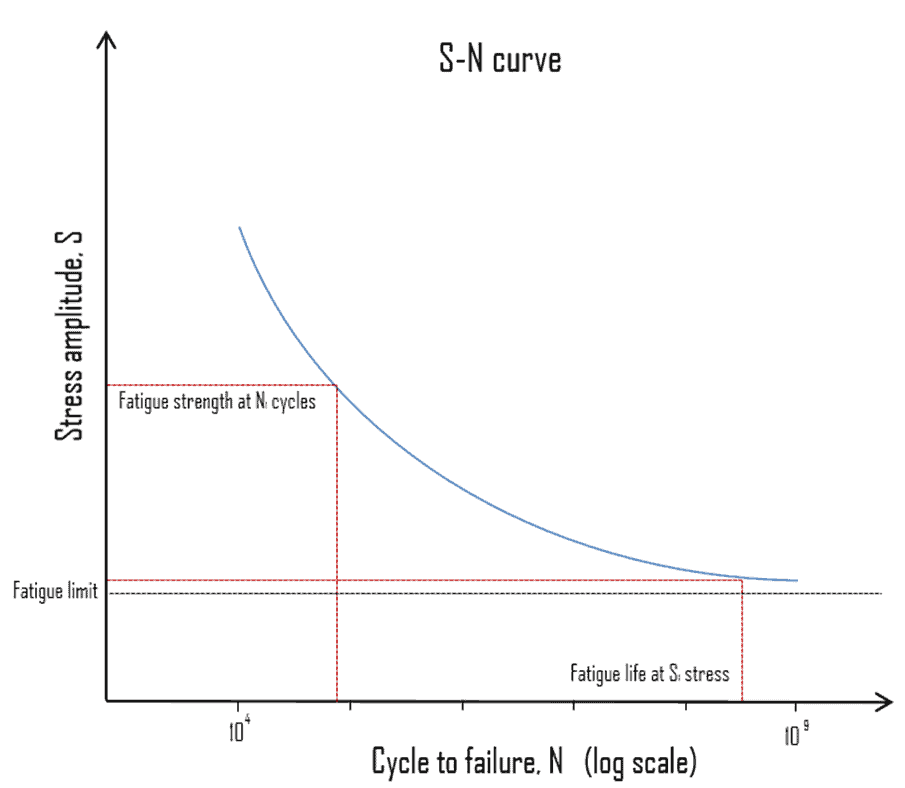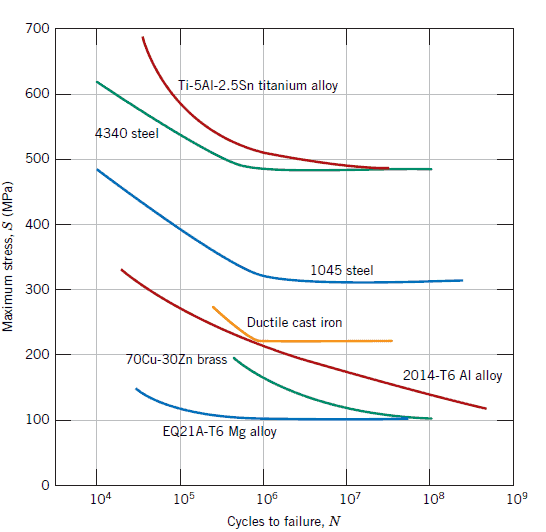In materials science, fatigue is the weakening of a material caused by cyclic loading, resulting in progressive, brittle, and localized structural damage. Once a crack has been initiated, each loading cycle will grow the crack a small amount, even when repeated alternating or cyclic stresses are of an intensity considerably below the normal strength. The stresses could be due to vibration or thermal cycling. Fatigue damage is caused by:
- simultaneous action of cyclic stress,
- tensile stress (whether directly applied or residual),
- plastic strain.
A fatigue crack will not initiate and propagate if any of these three is not present. The majority of engineering failures are caused by fatigue.
Although the fracture is of a brittle type, it may take some time to propagate, depending on the intensity and frequency of the stress cycles. Nevertheless, there is very little warning before failure if the crack is not noticed. The number of cycles required to cause fatigue failure at a particular peak of stress is generally quite large, but it decreases as the stress increases. For some mild steels, cyclical stresses can be continued indefinitely provided the peak stress (sometimes called fatigue strength) is below the endurance limit value. A good example of fatigue failure is breaking a thin steel rod or wire with your hands after bending it back and forth several times in the same place. Another example is an unbalanced pump impeller resulting in vibrations that can cause fatigue failure. The type of fatigue of most concern in nuclear power plants is thermal fatigue. Thermal fatigue can arise from thermal stresses produced by cyclic changes in temperature. Large components like the pressurizer, reactor vessel, and reactor system piping are subject to cyclic stresses caused by temperature variations during reactor startup, changes in power level, and shutdown.
Fatigue Life – S-N Curve

The American Society for Testing and Materials defines fatigue life, Nf, as the number of stress cycles of a specified character that a specimen sustains before failure of a specified nature occurs. Fatigue life is affected by cyclic stresses, residual stresses, material properties, internal defects, grain size, temperature, design geometry, surface quality, oxidation, corrosion, etc. For some materials, notably steel and titanium, there is a theoretical value for stress amplitude below which the material will not fail for any number of cycles, called a fatigue limit, endurance limit, or fatigue strength.
Engineers use several methods to determine a material’s fatigue life. One of the most useful is the stress-life method is commonly characterized by an S-N curve, also known as a Wöhler curve. This method is illustrated in the figure. It plots applied stress (S) against component life or the number of cycles to failure (N). As the stress decreases from some high value, component life increases slowly at first and then rapidly. Because fatigue like brittle fracture has such a variable nature, the data used to plot the curve will be treated statistically. The scatter in results is a consequence of the fatigue sensitivity to many tests and material parameters that are impossible to control precisely.
The following terms are defined for the S-N curve:
- Fatigue Limit. Fatigue (also called the endurance limit) is the stress level below which fatigue failure does not occur. This limit exists only for some ferrous (iron-based) and titanium alloys, for which the S–N curve becomes horizontal at higher N values. Other structural metals, such as aluminium and copper, do not have a distinct limit and will eventually fail even from small stress amplitudes. Typical values of the limit for steels are 1/2 the ultimate tensile strength, to a maximum of 290 MPa (42 ksi).
- Fatigue Strength. The ASTM defines fatigue strength, SNf, as the value of stress at which failure occurs after some specified number of cycles (e.g., 107 cycles). For example, the fatigue strength for annealed Ti-6Al-4V titanium alloy is about 240 MPa at 107 cycles, and the stress concentration factor = 3.3.
- Fatigue Life. Fatigue life characterizes a material’s fatigue behavior. It is the number of cycles to cause failure at a specified stress level, as taken from the S–N plot.
The process of fatigue failure is characterized by three distinct steps:
- Crack initiation, a small crack forms at some point of high-stress concentration.
- Crack propagation, during which this crack advances incrementally with each stress cycle. Most of the fatigue life is generally consumed in the crack growth phase.
- Ultimate failure occurs rapidly once the advancing crack has reached a critical size.
Cracks associated with fatigue failure almost always initiate (or nucleate) the surface of a component at some point of stress concentration. Anything which leads to stress concentration, and the development of cracks, will reduce fatigue life. Therefore, increasing the degree of surface finish, polishing compared to grinding, improves fatigue life. Increasing the strength and hardness of the surface layers of metal components will also improve fatigue life.

High Cycle Fatigue vs. Low Cycle Fatigue
Fatigue has been separated into regions of high cycle fatigue and low cycle fatigue. The chief difference between high cycle and low cycle fatigue is the number of cycles to failure. The transition between LCF and HCF is determined by the stress level, i.e., the transition between plastic and elastic deformations.
- High-cycle fatigue requires more than 104 cycles to failure, where stress is low and primarily elastic.
- Low cycle fatigue is characterized by repeated plastic deformation (i.e., in each cycle); therefore, the number of cycles to failure is low. In the plastic region, large changes in strain can be produced by small changes in stress. Experiments have shown that low cycle fatigue is also crack growth.
Fatigue failures, both for high and low cycles, all follow the same basic steps process of crack initiation, stage I crack growth, stage II crack growth, and finally, ultimate failure.